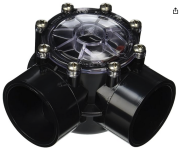Yes, I am doing all the pumping at 100% speed (3450 rpm).
Like you, I have decided that I've done enough diagnostic testing. I am going to replumb everything plastic that is visible above concrete to the pump (I will need to leave the copper pipe there). I am planning a new transition coupling at the copper pipe and new PVC and possibly see if I can add a good check valve on the way to the pump. The union at the pump will also be replaced as long as I am sure what I buy will fit well onto the pump.
I do think the underground pipe is all copper. The pool was installed by an earlier house owner in 1977 (according to city permit records). Also, the pipes leaving the skimmer are also metal (probably copper, but they are below the skimmer, and by feel they are definitely metal of some sort).
I am pretty sure that the transition fitting between the copper pipe and PVC is this type of so-called "compression" fitting shown below. From the image (which came from a pool supply website) it looks like a "SharkBite"-type of O-ring connection to the copper pipe. That's not ideal, but it is what it is, and I will just replace it whenever it starts leaking.

The description for this item is: 21098-150-000 Copper to PVC Adapter 1.5in. to 2 in. / 1.5in. PVC
Please let me know if you think I'm way off or anything (or if it all looks okay).
Thanks for your help Ol_whistle and everyone else. It really helps to have people to discuss these problems with.
Like you, I have decided that I've done enough diagnostic testing. I am going to replumb everything plastic that is visible above concrete to the pump (I will need to leave the copper pipe there). I am planning a new transition coupling at the copper pipe and new PVC and possibly see if I can add a good check valve on the way to the pump. The union at the pump will also be replaced as long as I am sure what I buy will fit well onto the pump.
I do think the underground pipe is all copper. The pool was installed by an earlier house owner in 1977 (according to city permit records). Also, the pipes leaving the skimmer are also metal (probably copper, but they are below the skimmer, and by feel they are definitely metal of some sort).
I am pretty sure that the transition fitting between the copper pipe and PVC is this type of so-called "compression" fitting shown below. From the image (which came from a pool supply website) it looks like a "SharkBite"-type of O-ring connection to the copper pipe. That's not ideal, but it is what it is, and I will just replace it whenever it starts leaking.

The description for this item is: 21098-150-000 Copper to PVC Adapter 1.5in. to 2 in. / 1.5in. PVC
Please let me know if you think I'm way off or anything (or if it all looks okay).
Thanks for your help Ol_whistle and everyone else. It really helps to have people to discuss these problems with.






